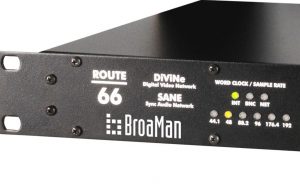BroaMan’s Marc Brunke hails increased flexibility and efficiency of latest Route66 devices
 Day 2 at IBC 2016 saw BroaMan technical director and Optocore founder Marc Brunke introduce three new versions of its Route66 router to the trade media, highlighting the fact that the latest iterations have their origins in a major project for a Scandinavian broadcaster.
Day 2 at IBC 2016 saw BroaMan technical director and Optocore founder Marc Brunke introduce three new versions of its Route66 router to the trade media, highlighting the fact that the latest iterations have their origins in a major project for a Scandinavian broadcaster.
“It was September 2011 and a systems integrator needed a smart video network for a [broadcaster HQ located] in Stockholm,” he recalls. The request was, he notes wryly, “both impossible and unheard-of, so it was up to us to find a solution as we are the most prominent company for audio/video networking.”
The ensuing Route66 products are the result of a significant effort to turn the customised solutions produced for various customers “into more of a standard” solution. The three products introduced at IBC 2016 feature a 2RU design, said to be a result of customer feedback and the multiple projects already delivered. Going forward, the Route66 platform will provide single channel, non-blocking 40 x 40 router ports in three versions – all with directly accessible fibre SFP (Small Form Factor Pluggable) or SDI. Additionally, each new Route66 features fibre ports which can be used to access built-in CWDM or DWDM multiplexers.
The first version of Route66 will offer fibre only, with 40 hot-swappable bi-directional SFPs; Version 2 will have 32 SFPs and 16 x SDI (8-In and 8-Out); Version 3 will have 24 SFPs and 32 SDI (16-In and 16-Out).
The new Route66 provides protocol-independent routing and transport, supporting all professional standards such as 3G, SDI, HD, 3G-SDI, ASI and MADI. The built-in redundant power supplies offer extremely low power consumption of 10-40W, making the system ‘significantly more cost efficient’ than competitive models which depend on external 120W PSUs. The new models also feature an efficient passive cooling system, which replaces noisy fans.
BroaMan MD Tine Helmle highlights the different combinations of SDI, SFP and CWDM multiplexers as a particular advantage. “In addition every SFP port is bi-directional (both input and output) for maximum channel count — unlike many competitive models, which have switchable I/O, thereby losing valuable ports. At the same time custom configuration is easily accomplished on point of manufacture, with on-site change of SFPs, as well as via BroaMan or third party software.”
The new Route66 devices – which begin shipping later this month – also contain an advanced network from OEM partner Optocore for IP monitoring and control, audio and intercom (eg ClearCom, RTS and Riedel etc), routing and transport – as well as providing additional transport of GPIO, RS485 and LAN.
All connections are to the rear, making Route66 installation friendly. The front panel provides status information only, with no cabling or service buttons.
Finally, Route66 can become a part of a Video AutoRouting System array (as deployed at broadcasters, SVT in Sweden and the new ITV Coronation Street set at MediaCityUK in Manchester).
Other features include: Video Sync transport with sync signals converter for the most commonly used signals: WC, BB, TriLevel; Camera CCU (without power) transport and routing up to 4G; full offline software for preconfigurations.
